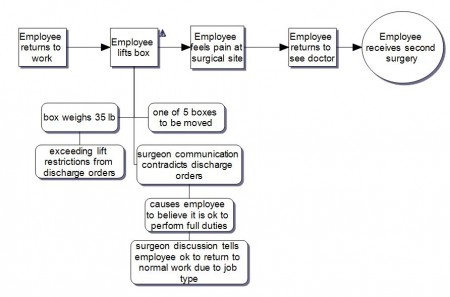Communication’s Role in Healthcare Events
Communication has always been an issue within healthcare. From the earliest days of TJC alerts and the Event RCA guidance, communication has been a focus. There are multiple communication threads between practitioners, nurses, patients and family that create many avenues for possible problems.
As an example, I will use a story told to me by a friend regarding a recent surgical procedure. I will not try to recount the actual surgery as it is not truly relevant to this discussion. I will, however, start this story in Recovery after the person underwent surgery with no complications. During post-surgery recovery, they were provided with their formal discharge instructions from the nurse which included the following:
1) No lifting over 25 lbs for 1 week.
2) May return to work the next day.
3) Other medicine related and wound care information included.
After getting these instructions but before being discharged the surgeon came by to check on the patient and briefly discuss the procedure. During the discussion the following exchange occurred:
Patient asked the surgeon “Can I go back to work Monday?”
Surgeon asked, “What do you do?”
Patient answered, “Course setup and planning.”
Surgeon answered without hesitation, “You should be able to go back to work and perform that job without an issue”.
End of discussion.
See any potential problems with this communication? Any conflicting information? Very interesting isn’t it? Now, if we examine the duties within “Course setup and planning”:
1) Packing boxes
2) Shipping boxes
3) Lifting boxes
4) Computer work
5) Course Documentation
We can immediately determine that this job should be restricted based on the original instructions provided by the RN in the formal discharge instructions. But as with most people the words and advice from the surgeon were the ones that were heeded. My friend went to work on the next work day and continued to lift boxes that were in fact greater in weight than what was allowed. Now, in this case there was no additional injury, there were no complications, but this showed me in a glaring way how communications could cause a problem.
Now, had my friend had a complication and was forced to go back and receive an additional surgery, would this issue have been found as part of the RCA (if one were performed)? Did the communication have a role in the event? Here is a possible causal factor:

So during the examination of any event whether high or low risk, it is important to consider the impact of the spoken word. Looking into all communications that are involved to ensure that the messages sent match the messages heard. And that there are no conflicting communications that can cause confusion or set the patient or family up for failure. If you would like more information on how to consistently analyze healthcare related events using TapRooT® please feel free to contact me at: skompski@taproot.com.
Learn more about Healthcare RCA at the 2016 Global TapRooT® Summit.




